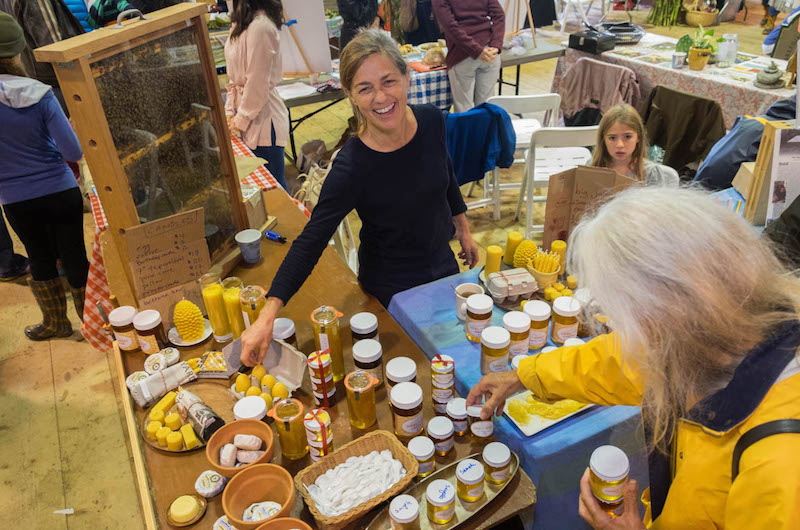At the Living Local Harvest Festival on Saturday, three-year-old Griffin Neago asked his dad to help him carve a nose just like his own into his Jack-o’-lantern. His older brother Tristan, age six, shook his head wisely.
“They aren’t going to last to Halloween,” he said. But that didn’t stop Tristan from joining in on the fun, as he went to work on a pumpkin of his own, chiseling out a triangle eye with precision.
After days of drenching rain, the skies didn’t fully clear over the Agricultural Hall for the annual festival that celebrates all things local, sustainable and communal, but they did stay a more pleasurable dry gray. All day long large crowds enjoyed workshops on energy conservation, outdoor education, seed saving, bee keeping, bread making, the list was long. There was also food made from local ingredients and music played by Island neighbors.
Emily Armstrong from Island Grown Initiative and Larissa Rich from MV Garden Club and the Lagoon Pond Association started the day off with a talk about compost.
“This is my worm bin,” said Ms. Armstrong, displaying a gray plastic tub. She and her 1,000 wriggling helpers gave basic instructions for starting a small transportable compost tub, including how to avoid rodent problems by not composting cooked food, dairy or meat.
Ms. Rich demonstrated how to make compost tea, a probiotic brew that is easy to spread in a garden for extra nutrients.
“It’s a wonderful time of the year to feed your garden soil,” said Ms. Rich. She held up a bucket she had fitted with a hose to create a makeshift watering can for the tea.
A boy in a ninja turtle sweatshirt sat at the front of the Felix Neck presentation where Josey Kirkland shared facts about local reptiles and amphibians, bringing out turtles and frogs as examples. Brave kids gently stroked the belly of a spotted turtle, feeling for a dent to determine if it was a boy or girl.
Turtles were a popular presence at the festival. Sasha Lakis and three of her eighth grade classmates from Oak Bluffs talked about how to protect box turtles from lawn mowers and cars. Sasha carefully handled Johnny Sue, a domesticated box turtle no longer able to survive in the wild.
“It’s like the heath hen all over again,” Sasha said, explaining how the turtles on the Island are genetically different from other eastern box turtles, and in danger of extinction because of human activity.
Children painted box turtles moulded out of clay or on a smooth stone, and added googly-eyes to create new pocket-sized pets.
Amandine Hall and Marcella Andrews from MV Shellfish Group, discussed their kelp line experiment, currently in its second year. The women are working on growing and harvesting seaweed, specifically Saccharina Latissima, a sweet kelp, common in seaweed salad.

Bill Manson of the Local Wild Food Challenge, a competition focusing on locally foraged or hunted ingredients, spoke about his event which takes place next Sunday at the P.A. Club in Oak Bluffs. Mr. Manson said as long as one ingredient is wild, the dish can be entered.
“It doesn’t necessarily mean you’re out with your barrel gun, bow and arrow or fishing rod,” Mr. Manson said. “It can be as simple as walking down your local street and going for a forage.”
He mentioned golden rod, mustard seed, feral fennel and violets as Island foraging finds.
“This stuff is out there and it’s free and it’s good for you,” he said. Mr. Manson passed around pieces of a feral pear tort for his audience to try. As long as you know it’s edible, Mr. Manson urged, “pick it up and go for it.”
In the seed tent, a demonstration about making tortillas from scratch had participants grinding their own corn and chopping vegetables for fresh salsa. Clam chowder made the original Wampanoag way, without dairy (they had no cows), was poured into sample cups at the back of the tent as visitors browsed the seed library.
Gloria, a four-month-old black cow, gamboled around her pen, an unwitting participant in cow chip bingo. Inside the hall, Sally Pierce from Slow Food Martha’s Vineyard, passed out seltzers flavored with foraged beach plums and grapes.
“Part of it is to look around and see what’s there and what you can do with it,” she said.
Which, in a sense, is what the day was all about — a delicious reminder that sustainability on a global scale, takes place on a community level. Every bite of locally sourced food not only tastes better and is more nutritious, it cuts down on the harmful effects of transporting the food.
And as darkness fell, the evening potluck and contra dance started up, yet another reminder that the Vineyard has returned to a quieter time after a busy summer season.






Comments
Comment policy »